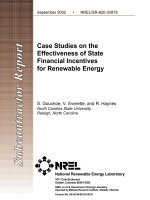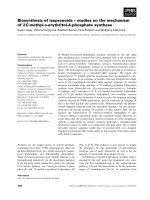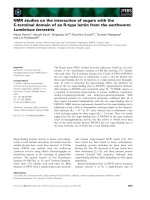Modelling studies on surface roughness of laminated glass cut by abrasive water jet
Bạn đang xem bản rút gọn của tài liệu. Xem và tải ngay bản đầy đủ của tài liệu tại đây (534.59 KB, 8 trang )
International Journal of Mechanical Engineering and Technology (IJMET)
Volume 11, Issue 1, January 2020, pp. 1-8, Article ID: IJMET_11_01_001
Available online at />ISSN Print: 0976-6340 and ISSN Online: 0976-6359
© IAEME Publication
MODELLING STUDIES ON SURFACE
ROUGHNESS OF LAMINATED GLASS CUT BY
ABRASIVE WATER JET
Hemavathy S, T Anil Kumar, Bijayalakshmi Das
Ramaiah Institute of Technology, Bangalore, India
Aradhya S M*
Kalpataru Institute of Technology, Tiptur, India
*Corresponding Author
ABSTRACT
Abrasive waterjet (AWJ) is a non-traditional machining process used for cutting
ductile, brittle and hard materials. AWJ cuts almost all materials, absence of thermal
distortion, high flexibility, smaller cutting forces, no heat affected zone and being
environmentally friendly. In the present study an attempt has been made to study
Depth of Cut (DOC) and Surface Roughness of laminated glass cut by AWJ. Jet
Pressure (p), Speed of Traverse (u) and Flow rate of abrasive (ṁ) are varied at three
different levels. A total of 27 experiments considering different levels of parameters
have been carried out on a trapezoidal shaped laminated glass of 38 mm thickness.
DOC is measured with height measuring gauge. The effect of parameters on surface
roughness and DOC is obtained through main effect plot. Surface Roughness (Ra)
values are measured at the wear region along cut direction. Dimensional analysis
modelling for Ra is carried out to predict the model equation for Ra by Buckingham’s
π –method. Comparison of model average Ra and experimental average Ra is carried
out to predict the suitability of the model.
Keywords: Abrasive Waterjet (AWJ), Statistical Modelling, Mathematical modeling.
Cite this Article: Hemavathy S, T Anil Kumar, Bijayalakshmi Das, Aradhya S M,
Modelling Studies on Surface Roughness of Laminated Glass Cut by Abrasive Water
Jet. International Journal of Mechanical Engineering and Technology 11(1), 2020, pp.
1-8.
/>
1. INTRODUCTION
Abrasive Water Jet (AWJ) cutting is one of the un conventional machining processes
employed in industry. In this process, high velocity of water and abrasive particles are
employed to for material removal. A stream of abrasive particles are introduced into the
stream of water and is made to impinge on to the work material with a high velocity. AWJ is
mainly used to cut materials such as ceramics, metals, wood, marbles, and layered composites
/>
1
Hemavathy S, T Anil Kumar, Bijayalakshmi Das, Aradhya S M
[1] [3] [4]. Surface roughness is an important parameter that ensures the quality of machined
part. Quality of product has a direct relation with the surface roughness. Many literatures
highlights the machining performance in AWJM for materials like tiles, marbles, glass,
aluminum, etc. Cutting of laminated glass by traditional machining is difficult due to reasons
such as delamination, surface damage and poor finish. It may also require secondary
operations like trimming and drilling. It is found an unsafe practice in cutting both sides
separately. During conventional cutting it is difficult to cut this laminated glass because it
results in delamination or breakage. Also surface finish is not so good, sharp edges are formed
at the cutting surface. Hence AWJ cutting of laminated glass is studied in the present work.
Ushasta Aich et al. [1] has carried out an investigation on borosilicate glass cut by AWJ
machining. In this investigation depth of cut [DOC] is measured for varying cutting
parameters such as standoff distance, traverse speed, abrasive flow rate, and water pressure.
The results so obtained are in-line with experimental results. Kumar Abhishek et al. [2]
employed grey relational analysis for optimizing the process parameters to machine holes on
soda lime glass and the result of confirmation test was found to be better. UshastaAich et al.
[3] has conducted experiment on cutting of borosilicate glass by AWJ machining. Material
removal rate (MRR) and DOC are measured with different settings of parameters-water
pressure, abrasive flow rate, traverse speed and standoff distance. Regression model of DOC
has been developed and the validation result of the estimated model favors the practical use of
the model in the chosen range. Dr. M. Chithirai Pon Selvan [4] carried out an investigation on
surface roughness which is an important cutting performance measure in AWJ cutting of
borosilicate glass. Taguchi’s design of experiments was carried out in order to collect surface
roughness values. Experiments were conducted by varying the traverse speed, abrasive flow
rate, standoff distance and water pressure for cutting borosilicate glass using abrasive water
jet cutting process. This experimental study has resulted in increased surface smoothness with
reduced standoff distance. Deepak Doreswamy et. al. [5] has reported the effect of AWJ
machining parameters on kerf width, on graphite filled glass fiber reinforced epoxy
composite. Experiments were conducted based on Taguchi’s L27 orthogonal arrays. The
regression models were developed to predict kerf width. Scanning electron microscope is used
to study the Surface morphology. Optimized Process parameters ensures small kerf width.
R.Prabhu, V.Thirunavukkarasu [8] has worked on the influence of various process parameters
in abrasive water jet machining while machining the Bullet proof glass. Surface roughness is
measured with different process parameter. Waterjet pressure, abrasive flow rate, standoff
distance and traverse speed are improved together by using Taguchi Grey Relational Analysis.
M. Chithirai Pon Selvan and Dr. N. Mohana Sundara Raju [9] reported the influence of
process parameters on surface roughness (Ra) of cast iron. Taguchi’s design of experiments
was used and experiments were carried out by varying waterjet pressure, traverse speed,
abrasive mass flow rate and standoff distance. It was found that surface roughness reduces as
standoff distance decreases. Derzija Begic-Hajdarevic et al. [10] studied the surface roughness
in AWJ cutting of Aluminium workpiece. Surface roughness was measured by using
Mitutoyo stylus instrument across the depth of cut. There was a marginal change in the
surface roughness upon increasing the abrasive mass flow rate. R.Horváth et.al. [11] carried
out research on examination of average surface roughness in waterjet cutting and factorial
design of experiments were used for further optimization. The surface roughness value is
measured at different places. It was found thickness of the material is very important factor
that affects the surface roughness. The Empirical model has been constructed to calculate
average surface roughness (Ra) and was found to be in good relation with the experimental
results. Vlatko Marušić et.al [12] studied the effects of machining parameters on jet lagging in
AWJ cutting.
/>
2
Modelling Studies on Surface Roughness of Laminated Glass Cut by Abrasive Water Jet
2. EXPERIMENTATION
2.1. Material
In the present investigation laminated glass of size 300 x 300 x 38mm (as show in figure 1) is
used as specimen. The laminated glass is cut to trapezoidal shape at an angle of 45°. The AWJ
machine is used for cutting of laminated glass is as shown in Figure 2. The machine is
equipped to operate in the range between the pressure values of 1000 bar and 4500 Bar and
maximum traverse speed of 8000 mm/min with drive motor power of 45 KW.
In the present investigation waterjet pressure (MPa), abrasive flow rate (kg/min) and
traverse speed (mm/min) are considered as control parameters. Garnet of #80 mesh size is
used for AWJ cutting. Depth of cut (DOC) and surface roughness (Rₐ) are measured.
Figure 1: Laminated glass specimen
Figure 2: Abrasive Water Jet Machine
Initially cutting parameters were determined by literature review and then preliminary
experiments are done, and finally cutting parameters are adjusted in an attempt to get the
desired response. Water pressure p (Mpa), Traverse speed u (m/min) & Mass flow rate ṁ
(g/min) were selected as input parameters in the present study and three-level design is
employed for modelling. By the preliminary experiment conducted using the above
parameters glass was found to exhibit abrupt behavior of breaking in 300 MPa water pressure,
traverse speed of 700 mm/min. and hence water pressure was limited to 200 MPa. In order to
meet the above criteria L27 orthogonal array has been chosen and three levels are selected
based on Taguchi method DoE. The different levels of parameters are mention in the Table 1
given below.
Table 1: Levels of parameters used in experiment
SL NO
1
Parameters
Water pressure p (Mpa)
Level 1
100
Level 2
150
Level 3
200
2
Traverse speed u (m/min)
300
400
500
3
Mass flow rate ṁ (g/min)
199
309
425
The cutting experiment is carried out on the laminated glass with the above stated
parameter values from preliminary experimentation. The experimentation is conducted for the
27 combinations of the selected input parameters. Depth of cut (DoC) and surface roughness
is measured for each trial.
2.3. Measurement of DOC
The depth of cut (DOC) is measured using height measuring gauge as shown in figure 3.
/>
3
Hemavathy S, T Anil Kumar, Bijayalakshmi Das, Aradhya S M
Figure 3: Height measuring gauge
2.4. Measurement of Surface Roughness
The Rₐ is measured using Mitutoyo surface tester and it is measured for all the 27 experiments
at cutting wear region along the DOC. The stylus material is a diamond tip of radius 5μm with
sensor moving along the surface of the sample.
Figure 4. Mitutoyo surface roughness test instrument
3. RESULT AND DISCUSSIONS
The results for DOC and Ra is shown in the below table
Table 2. Experimental results of DOC and Ra
EXP.NO
1
2
3
4
5
6
7
8
9
10
11
12
13
14
p[MPa]
100
100
100
100
100
100
100
100
100
150
150
150
150
150
ṁ[kg/min]
0.199
0.199
0.199
0.309
0.309
0.309
0.425
0.425
0.425
0.199
0.199
0.199
0.309
0.309
/>
u[mm/min]
300
400
500
300
400
500
300
400
500
300
400
500
300
400
4
DOC[mm]
13
11.5
10
15
11
9
13.5
12
11
22.5
18
17
21
18
Average Ra (μm)
3.565
3.685
3.67
3.65
3.43
3.61
3.635
3.65
3.87
4.10
3.816
4.06
4.19
4.08
Modelling Studies on Surface Roughness of Laminated Glass Cut by Abrasive Water Jet
EXP.NO
15
16
17
18
19
20
21
22
23
24
25
26
27
p[MPa]
150
150
150
150
200
200
200
200
200
200
200
200
200
ṁ[kg/min]
0.309
0.425
0.425
0.425
0.199
0.199
0.199
0.309
0.309
0.309
0.425
0.425
0.425
u[mm/min]
500
300
400
500
300
400
500
300
400
500
300
400
500
DOC[mm]
15
19
18
16.5
24.5
23.5
22
28
24.5
23
28.5
24
22.5
Average Ra (μm)
3.62
4.036
3.656
3.823
3.856
4.204
4.21
3.596
3.903
4.023
4.25
3.996
4.218
The maximum DOC is obtained for highest water pressure of 200 MPa and highest
abrasive mass flow rate of 0.425 kg/min with lowest traverse speed of 300 mm/min cutting
condition. At higher water pressure, more amount of kinetic energy is available with the
water. This high pressure water coupled with high abrasive flow rate will provide more water
jet energy and more number of cutting edges of abrasive particles for cutting of glass. In
addition, lesser traverse speed of water jet will assist this high pressure water with more
number of abrasive particles to cut at a point for more duration of time when compared to
lesser traverse speed jet. The above reasons will help in achieving higher DOC.
Similarly, minimum DOC is achieved for lower water jet pressure of 100 MPa with
abrasive mass flow rate of 0.199 kg/min and higher traverse speed of 500 mm/min cutting
condition. At lower water jet pressure less amount of energy is available for cutting of glass.
This low pressure of water is coupled with low abrasive flow rate thus providing less water jet
energy followed by reduction in number of cutting edges of abrasive particles for cutting of
glass. In addition, higher traverse speed of water jet will assist low pressure water with less
abrasive particles to cut at a point for less duration of time. Hence this is the reason for lower
DOC.
Surface roughness is measured along the DOC for all 27 experimental specimens on the
cutting wear zone only due to the limitations on use of Mitutoyo surface tester. The
measurements are conducted from the top surface to one-third the distance from top surface of
the cut. This region is considered to be cutting wear region. Table 2 shows the average R a for
all 27 experimental conditions.
3.1. Main effect plots for Depth of cut
The main effect plot is used to find the influence of the process parameters. Figure 6 shows
the influence of process parameters on DOC of laminated glass cut by AWJ cutting process
using Minitab software package. The best combination of input parameters to optimize DOC
can be easily found from this plot. From Figure 5, it has seen that the water pressure and
traverse speed slope is more, hence these two parameters has greater influence on the DOC.
/>
5
Hemavathy S, T Anil Kumar, Bijayalakshmi Das, Aradhya S M
Figure 5. Main effect plot of process parameters on DOC
3.2. Mathematical Modeling of Rₐ
In the present study Buckingham’s π –method is used to determine the relationship between
Rₐ and Water pressure (p), abrasive mass flow rate (ṁ) & Traverse speed (u):
̇
𝑅𝑎 = 𝑓(𝑝 𝑚 𝑈)
𝜋1 = 𝑝𝑎 𝑚𝑏 𝑢̇ 𝑐 𝑅𝑎
(1)
1
1
1
,𝑏 = −2& 𝑐 = −2
1 ̇ 1
So, 𝜋1 = 𝑝 𝑚̇−2 𝑢−2 𝑅𝑎
Solving, a =
2
1
2
𝒑
𝝅𝟏 = 𝑹𝒂 √𝒎𝒖̇
(2)
Using power law
𝑎
𝑅𝑎 =
̇ 1∗2
𝑚𝑢
𝑏( 𝑝 )
(3)
Where a & b are constants to be evaluated from experimental data
On solving,
a= -0.13 & b=6.05
Finally, the model equation for Rₐ is
̇ −𝟎.𝟎𝟔𝟕
𝒎.𝒖
)
𝒑
𝑹𝒂 = 𝟔. 𝟎𝟓 (
(4)
So this is the model equation to find average Rₐ on cutting wear region.
Percentage of error =
𝐦𝐨𝐝𝐞𝐥𝐑 𝒂 − 𝐀𝐯𝐞𝐫𝐚𝐠𝐞 𝐞𝐱𝐩𝐞𝐫𝐢𝐦𝐞𝐧𝐭𝐚𝐥 𝐑 𝒂
𝐦𝐨𝐝𝐞𝐥 𝐑 𝒂
(5)
The graph below shows the experimental surface roughness and the surface roughness
values obtained using mathematical modeling:
/>
6
Modelling Studies on Surface Roughness of Laminated Glass Cut by Abrasive Water Jet
Figure 6
The minimum model Rₐ valve is 3.62 μm obtained for cutting condition 100 MPa waterjet
pressure, 0.425 kg/min of abrasive flow rate and 500 mm/min of traverse speed. The
maximum Rₐ valve is 4.133 μm obtained for the cutting conditions of 200 MPa waterjet
pressure, 0.199 kg/min abrasive flow rate and 300 mm/min traverse speed. The Rₐ valves
obtained from modelling are compared with average experimental Rₐ and the error in terms of
percentage is calculated. Then comparison of model Rₐ and average experimental Rₐ were
made, the proposed model predicted almost ±10% Rₐ value than the experimental values.
4. CONCLUSION
In the present work, analysis of DOC and model equation for surface roughness R ₐ for
laminated glass cut by AWJ is developed. The experiments were done on the 38mm thickness
of trapezoidal shaped laminated glass. Water pressure is the main reason for higher DOC
compared to abrasive flow rate and traverse speed. The lowest average Rₐ value for the
cutting wear region is 3.43 (μm) is obtained for cutting condition of Waterjet pressure p 100
MPa, abrasive flow rate ṁ 0.309 kg/min & traverse speed u 400 mm/min. For better Rₐ values
higher waterjet pressure (p), higher Mass flow rate ṁ and lower traverse speeds are
recommended. Similarly for Waterjet pressure p of 200MPa, abrasive flow rate ṁ of
0.425kg/min & traverse speed u of 500mm/min has the highest average Rₐ value for the
cutting wear region is 4.218 (μm).
REFERENCES
[1]
Ushasta Aicha, Simul Banerjeea, Asish Bandyopadhyaya, Probal Kumar Das Abrasive
Water Jet Cutting of Borosilicate Glass, (2014) 775 – 785
[2]
Kumar Abhishek, Somashekhar S Hiremath, Machining of Micro-holes on Sodalime
Glass using Developed Micro- Abrasive Jet Machine (μ-AJM), (2016) 1234 – 1241
[3]
Dr. M. Chithirai Pon Selvan, Jerrin Varghese, Effects of Process Parameters on Surface
Roughness in Abrasive Water jet Cutting of Borosilicate Glass, (2016) Vol 1
[4]
UshastaAich1, Simul Banerjee, AsishBandyopadhyay, Probal Kumar Das, Simultaneous
modeling of responses in AWJM of Borosilicate glass by SVM and SEM study, (2014),
130-1 - 130-6
[5]
Deepak Doreswamy, Basavanna Shivamurthy, Devineni Anjaiah, and N. Yagnesh Sharma
An Investigation of Abrasive Water Jet Machining on Graphite/Glass/Epoxy Composite
Volume 2015, Article ID 627218, 11 pages
/>
7
Hemavathy S, T Anil Kumar, Bijayalakshmi Das, Aradhya S M
[6]
Victor Wessels,Anton Grigoryev & Eduardo Weingärtner, Abrasive waterjet machining of
three-dimensional structures from bulk metallic glasses and comparison with other
techniques, (2012) 1187- 1191
[7]
The Mechanical Properties of Glass Theoretical strength, practical strength, fatigue, flaws,
toughness, chemical processes Glass Engineering 150:312 Professor Richard Lehman
Department of Ceramics and Materials Engineering Rutgers University, New Brunswick,
New Jersey, USA
[8]
Optimization of machining parameters for machining bullet proff glass using awjm
R.Prabhu, V.Thirunavukkarasu, M.Ramasubramanian
[9]
M. Chithirai Pon Selvan and Dr. N. Mohana Sundara Raju analysis of surface roughness
in abrasive waterjet cutting of cast iron (2012) 174 - 182
[10]
P. Badgujar M. G. Rathi Analysis of Surface Roughness in Abrasive Waterjet Cutting Of
Stainless Steel Vol. 3 Issue 6, June - 2014
[11]
Peter Miles, Axel Henning a better measurement of abrasive waterjet cut surface finishes
September 9-11, 2013
[12]
Derzija Begic-Hajdarevica, Ahmet Cekica, Muhamed Mehmedovicb, Almina Djelmica
Experimental Study on Surface Roughness in Abrasive Water Jet Cutting (2015 ) 394 –
399
[13]
R. Horváth, Á. Drégelyi-Kiss, J. Lukács Examination of average surface roughness in
waterjet cutting 2016
[14]
Sai Shridhar Joshi, Chaitanya Shaligram :A Review Of Analysis Of Surface Roughness In
Abrasive Water Jet Cutting 2017 Volume 5
/>
8









